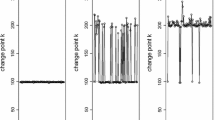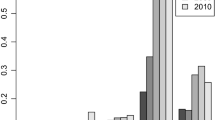Abstract
In this paper, we propose a Griddy-Gibbs sampler approach to estimate parameters and forecast volatilities for the power transformed and threshold GARCH (PTTGARCH; Pan et al. in J Econ 142:352–378, 2008) model, which includes the standard GARCH model and many other commonly used models as special cases. Simulation study indicates that the Bayesian scheme performs effectively in estimation and prediction. A real data example is presented to support our proposed Bayesian method.












Similar content being viewed by others
References
Adler, R. J., Feldaman, R. E., & Gallagher, C. (1997). In R. J. Adler, R. E. Feldaman, & M. Taqqu (Eds.), A User’s Guide to Heavy Tails: Statistical techniques for analyzing heavy tailed distribution and processes (pp. 133–158). Boston: Birkhauser.
Ausin, M. C., & Galeano, P. (2007). Bayesian estimation of the Gaussian mixture GARCH model. Computational Statistics and Data Analysis, 51, 2636–2652.
Bauwens, L., Bos, C. S., & Van Dijk, H. K. (1999). Adaptative polar sampling with an application to a Bayes measure of a value-at-risk. Working paper, CORE, Universite Catholique de Louvain.
Bauwens, L., & Lubrano, M. (1998). Bayesian inference on GARCH models using Gibbs sampler. Journal of Econometrics, 1, 23–46.
Bollerslev, T. (1986). Generalized autoregressive conditional heteroskedasticity. Journal of Econometrics, 31, 307–327.
Chen, C. W. S., & So, M. K. P. (2006). On a threshold heteroscedastic model. International Journal of Forecasting, 22, 73–89.
Davis, P. J., & Rabinowitz, P. (1975). Methods of Numerical Integration Academic. New York.
Ding, Z., Granger, C. W. J., & Engle, R. F. (1993). Long memory property of stock market returns and a newmodel. Journal of Empirical Finance, 1, 83–106.
Engle, R. F. (1982). Autoregressive conditional heteroscedasticity with estimates of variance of UK inflation. Econometrica, 50, 987–1008.
Geweke, J. (1984). Exact predictive densities in linear models with ARCH disturbances. Journal of Econometrics, 40, 63–86.
Geweke, J. (1994). Bayesian comparison of econometric models. Working paper, Federal Reserve Bank of Minneapolis.
Gouriéroux, C. (1997). ARCH models and financial applications. New York: Springer.
Glosten, L. R., Jagannathan, R., & Runkle, D. E. (1993). On the relation between the expected value and the volatility of the nominal excess return on stocks. The journal of finance, 48, 1779–1801.
Higgins, M. L., & Bera, A. K. (1992). A class of nonlinear ARCH models. International Economic Review, 33, 137–158.
Hoogerheide, L., & van Dijk, H. K. (2010). Bayesian forecasting of value at risk and expected shortfall using adaptive importance sampling. International Journal of Forecasting, 26, 231–247.
Hwang, S. Y., & Basawa, I. V. (2004). Stationarity and moment structure for Box–Cox transformed threshold GARCH(1,1) processes. Statistics and Probability Letters, 68, 209–220.
Hwang, S. Y., & Kim, T. Y. (2004). Power transformation and threshold modeling for ARCH innovations with applications to tests for ARCH structure. Stochastic Processes and Their Applications, 110, 295–314.
Jorion, P. (2000). Value at risk: The new benchmark for managing financial risk (2nd ed.). NewYork: McGraw-Hill.
Kupiec, P. (1995). Techniques for verifying the accuracy of risk management models. Journal of Derivatives, 3, 73–84.
Li, C. W., & Li, W. K. (1996). On a double-threshold auroressive heteroscedastic time series model. Journal of Applied Econometrics, 11, 253–274.
McKenzie, M., Mitchell, H., Brooks, R., & Faff, R. (2001). Power arch modelling of commodity futures data on the London metal exchange. European Journal of Finance, 7, 22–38.
McKenzie, M., & Mitchell, H. (1999). Generalised asymmetric power arch modeling of exchange rate volatility. Applied Financial Economics, 12, 555–564.
Mittnik, S., & Rachev, S. T. (2000). Stable Paretian Models in Finance. New York: Wiley.
Muller, P., & Pole, A. (1998). Monte Carlo posterior integration in GARCH models. Sankhya, 60, 127–144.
Nakatsuma, T. (2000). Bayesian analysis of ARMA-GARCH models: A Markov chain sampling approach. Journal of Econometrics, 95, 57–69.
Nelson, D. B. (1991). Conditional heteroscedasticity in asset returns: A new approach. Econometrica, 59, 347–370.
Pan, J., Wang, H., & Tong, H. (2008). Estimation and tests for power-transformed and threshold GARCH models. Journal of Econometrics, 142, 352–378.
Ritter, C., & Tanner, M. A. (1992). Facilitating the Gibbs sampler: The Gibss stopper and the Griddy-Gibbs sampler. Journal of the American Statistical Association, 87, 861–868.
Sendana, E. (1995). Quadratic ARCH models. Review of Economic Studies, 62, 639–661.
Tully, E., & Lucey, B. M. (2007). A power GARCH examination of the gold market. Research in International Business and Finance, 21, 316–325.
Vrontos, I. D., Dellaportas, P., & Politis, D. N. (2000). Full Bayesian inference for GARCH and EGARCH models. Journal of Business and Economic Statistics, 18, 187–198.
Yu, B., & Mykland, P. (1994). Looking at Markov samplers through CUMSUM path plots: A simple diagnostic idea. Technical Report 413. Department of Statistics, University of California at Berkeley.
Zakoian, J. M. (1994). Threshold heteroskedastic models. Journal of Economic Dynamics and Control, 18, 931–955.
Acknowledgments
The authors thank the editor, and the referees for their constructive suggestions and comments that led to a significant improvement of an early version of the manuscript. The research of Qiang Xia was supported by National Science Foundation of Guangdong Province of China (No. 2016A030313414) and National statistical plan for scientific research project of China (No. 2015LZ48). The research of Heung Wong was supported by a grant from the research committee of The Hong Kong Polytechnic University. The research of Rubing Liang was supported by National Science Foundation of Guangdong Province of China (No. 2015A030310365).
Author information
Authors and Affiliations
Corresponding author
Rights and permissions
About this article
Cite this article
Xia, Q., Wong, H., Liu, J. et al. Bayesian Analysis of Power-Transformed and Threshold GARCH Models: A Griddy-Gibbs Sampler Approach. Comput Econ 50, 353–372 (2017). https://doi.org/10.1007/s10614-016-9588-x
Accepted:
Published:
Issue Date:
DOI: https://doi.org/10.1007/s10614-016-9588-x




